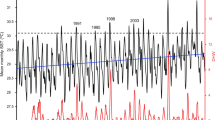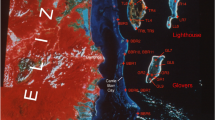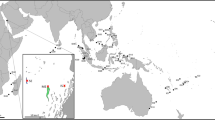Abstract
Human society is dependent on nature1,2, but whether our ecological foundations are at risk remains unknown in the absence of systematic monitoring of species’ populations3. Knowledge of species fluctuations is particularly inadequate in the marine realm4. Here we assess the population trends of 1,057 common shallow reef species from multiple phyla at 1,636 sites around Australia over the past decade. Most populations decreased over this period, including many tropical fishes, temperate invertebrates (particularly echinoderms) and southwestern Australian macroalgae, whereas coral populations remained relatively stable. Population declines typically followed heatwave years, when local water temperatures were more than 0.5 °C above temperatures in 2008. Following heatwaves5,6, species abundances generally tended to decline near warm range edges, and increase near cool range edges. More than 30% of shallow invertebrate species in cool latitudes exhibited high extinction risk, with rapidly declining populations trapped by deep ocean barriers, preventing poleward retreat as temperatures rise. Greater conservation effort is needed to safeguard temperate marine ecosystems, which are disproportionately threatened and include species with deep evolutionary roots. Fundamental among such efforts, and broader societal needs to efficiently adapt to interacting anthropogenic and natural pressures, is greatly expanded monitoring of species’ population trends7,8.
This is a preview of subscription content, access via your institution
Access options
Access Nature and 54 other Nature Portfolio journals
Get Nature+, our best-value online-access subscription
$29.99 / 30 days
cancel any time
Subscribe to this journal
Receive 51 print issues and online access
$199.00 per year
only $3.90 per issue
Buy this article
- Purchase on Springer Link
- Instant access to full article PDF
Prices may be subject to local taxes which are calculated during checkout






Similar content being viewed by others
Data availability
Raw data from the Reef Life Survey and Australian Temperate Reef Collaboration programmes are accessible through a live data portal accessed via either the Reef Life Survey (https://www.reeflifesurvey.com/) or Australian Ocean Data Network (https://portal.aodn.org.au/) websites using the keywords ‘National Reef Monitoring Network’. Sea surface temperature data were obtained from Coral Reef Watch (available through https://coralreefwatch.noaa.gov/product/5km/), chlorophyll data were obtained from Bio-ORACLE (https://www.bio-oracle.org/), fish trait data were obtained in part from Fishbase (https://www.fishbase.org/), and invertebrate trait data from Sealifebase (https://www.sealifebase.ca/), as described in Methods.
Code availability
Analytical computations were undertaken in R version 4.2.0 (using libraries tidyverse. janitor, zoo, magick, cowplot, scales, patchwork, ggplot, rag, gt, gtable, grid, nlme, here and kableExtra)57, as described in R markdown script available at https://github.com/FreddieJH/continental_reef_trends.
References
Whitmee, S. et al. Safeguarding human health in the Anthropocene epoch: report of The Rockefeller Foundation–Lancet Commission on planetary health. Lancet 386, 1973–2028 (2015).
Cardinale, B. J. et al. Biodiversity loss and its impact on humanity. Nature 486, 59–67 (2012).
Ceballos, G., Ehrlich, P. R. & Dirzo, R. Biological annihilation via the ongoing sixth mass extinction signaled by vertebrate population losses and declines. Proc. Natl Acad. Sci. USA 114, E6089–E6096 (2017).
Duffy, J. E. et al. Toward a coordinated global observing system for seagrasses and marine macroalgae. Front. Mar. Sci. 6, https://doi.org/10.3389/fmars.2019.00317 (2019).
Wernberg, T. et al. Climate-driven regime shift of a temperate marine ecosystem. Science 353, 169–172 (2016).
Hughes, T. P., Kerry, J. T. & Simpson, T. Large-scale bleaching of corals on the Great Barrier Reef. Ecology 99, 501 (2017).
Jetz, W. et al. Essential biodiversity variables for mapping and monitoring species populations. Nat. Ecol. Evol. 3, 539–551 (2019).
Day, J. The need and practice of monitoring, evaluating and adapting marine planning and management—lessons from the Great Barrier Reef. Mar. Policy 32, 823–831 (2008).
Loh, J. et al. The Living Planet Index: using species population time series to track trends in biodiversity. Phil. Trans. R. Soc. B 360, 289–295 (2005).
Vogel, G. Where have all the insects gone? Science 356, 576–579 (2017).
Vieilledent, G. et al. Combining global tree cover loss data with historical national forest cover maps to look at six decades of deforestation and forest fragmentation in Madagascar. Biol. Conserv. 222, 189–197 (2018).
Dirzo, R. et al. Defaunation in the Anthropocene. Science 345, 401–406 (2014).
Regan, E. C. et al. Global trends in the status of bird and mammal pollinators. Conserv. Lett. 8, 397–403 (2015).
Bergstrom, D. M. et al. Combating ecosystem collapse from the tropics to the Antarctic. Glob. Change Biol. 27, 1692–1703 (2021).
Watson, R. A. & Tidd, A. Mapping nearly a century and a half of global marine fishing: 1869–2015. Mar. Policy 93, 171–177 (2018).
Species Survival Commission. 2006 IUCN Red List of Threatened Species (IUCN, 2006).
Living Planet Report 2020—Bending The Curve of Biodiversity Loss (World Wildlife Fund, 2020).
Edgar, G. J., Ward, T. J. & Stuart-Smith, R. D. Rapid declines across Australian fishery stocks indicate global sustainability targets will not be achieved without expanded network of ‘no-fishing’ reserves. Aquat. Conserv. 28, 1337–1350 (2018).
Pitois, S. G., Lynam, C. P., Jansen, T., Halliday, N. & Edwards, M. Bottom-up effects of climate on fish populations: data from the continuous plankton recorder. Mar. Ecol. Progr. Ser. 456, 169–186 (2012).
Stuart-Smith, R. D. et al. Assessing national biodiversity trends for rocky and coral reefs through the integration of citizen science and scientific monitoring programs. BioScience 67, 134–146 (2017).
Knowlton, N. et al. in Life in the World’s Oceans: Diversity, Distribution and Abundance (ed. McIntyre, A. D.) 65–77 (Wiley–Blackwell, 2010).
Edgar, G. J. & Stuart-Smith, R. D. Systematic global assessment of reef fish communities by the Reef Life Survey program. Sci. Data 1, 140007 (2014).
Edgar, G. J. & Barrett, N. S. An assessment of population responses of common inshore fishes and invertebrates following declaration of five Australian marine protected areas. Environ. Conserv. 39, 271–281 (2012).
Emslie, M. J. et al. Decades of monitoring have informed the stewardship and ecological understanding of Australia’s Great Barrier Reef. Biol. Conserv. 252, 108854 (2020).
Edgar, G. J. et al. Establishing the ecological basis for conservation of shallow marine life using Reef Life Survey. Biol. Conserv. 252, 108855 (2020).
Hughes, T. P. et al. Global warming and recurrent mass bleaching of corals. Nature 543, 373–377 (2017).
Stuart-Smith, R. D., Brown, C. J., Ceccarelli, D. M. & Edgar, G. J. Ecosystem restructuring along the Great Barrier Reef following mass coral bleaching. Nature 560, 92–96 (2018).
Hughes, T. P. et al. Emergent properties in the responses of tropical corals to recurrent climate extremes. Curr. Biol. 31, 5393–5399.e5393 (2021).
Johnson, C. R. et al. Climate change cascades: shifts in oceanography, species’ ranges and subtidal marine community dynamics in eastern Tasmania. J. Exp. Mar. Biol. Ecol. 400, 17–32 (2011).
IUCN Standards and Petitions Working Group. Guidelines for Using the IUCN Red List Categories and Criteria, Version 7.0. http://intranet.iucn.org/webfiles/doc/SSC/RedList/RedListGuidelines.pdf (2008).
Fraser, K. M., Stuart-Smith, R. D., Ling, S. D. & Edgar, G. J. High biomass and productivity of epifaunal invertebrates living amongst dead coral. Mar. Biol. 168, 102 (2021).
Gilmour, J. P. et al. The state of Western Australia’s coral reefs. Coral Reefs 38, 651–667 (2019).
Long-Term Monitoring Program Annual Summary Report of Coral Reef Condition 2020/2021 (Australian Institute of Marine Science, 2021).
Eakin, C. M. et al. Caribbean corals in crisis: record thermal stress, bleaching, and mortality in 2005. PLoS ONE 5, e13969 (2010).
Edgar, G. J., Ward, T. J. & Stuart-Smith, R. D. Weaknesses in stock assessment modelling and management practices affect fisheries sustainability. Aquat. Conserv. 29, 2010–2016 (2019).
Babcock, R. C. et al. Decadal trends in marine reserves reveal differential rates of change in direct and indirect effects. Proc. Natl Acad. Sci. USA 107, 18256–18261 (2010).
Ling, S. D., Johnson, C. R., Frusher, S. D. & Ridgway, K. R. Overfishing reduces resilience of kelp beds to climate-driven catastrophic phase shift. Proc. Natl Acad. Sci. USA 106, 22341–22345 (2009).
Stuart-Smith, R. D., Edgar, G. J. & Bates, A. E. Thermal limits to the geographic distributions of shallow-water marine species. Nat. Ecol. Evol. 1, 1846–1852 (2017).
Chaudhary, C., Richardson, A. J., Schoeman, D. S. & Costello, M. J. Global warming is causing a more pronounced dip in marine species richness around the equator. Proc. Natl Acad. Sci. USA 118, e2015094118 (2021).
Bennett, S. et al. The ‘Great Southern Reef’: social, ecological and economic value of Australia’s neglected kelp forests. Mar. Freshwater Res. 67, 47–56 (2016).
Stuart-Smith, R. D. et al. Loss of native rocky reef biodiversity in Australian metropolitan embayments. Mar. Pollut. Bull. 95, 324–332 (2015).
Ling, S. D. et al. Pollution signature for temperate reef biodiversity is short and simple. Mar. Pollut. Bull. 130, 159–169 (2018).
Davies, T. E., Maxwell, S. M., Kaschner, K., Garilao, C. & Ban, N. C. Large marine protected areas represent biodiversity now and under climate change. Sci. Rep. 7, 9569 (2017).
Grech, A., Edgar, G. J., Fairweather, P., Pressey, R. L. & Ward, T. J. in Austral Ark (eds Stow, A., Maclean, N. & Holwell, G. I.) 582–599 (Cambridge Univ. Press, 2014).
Bates, A. E., Stuart-Smith, R. D., Barrett, N. S. & Edgar, G. J. Biological interactions both facilitate and resist climate-related functional change in temperate reef communities. Proc. R. Soc. B 284, 20170484 (2017).
Verges, A. et al. Tropicalisation of temperate reefs: Implications for ecosystem functions and management actions. Funct. Ecol. 33, 1000–1013 (2019).
Popova, E. et al. From global to regional and back again: common climate stressors of marine ecosystems relevant for adaptation across five ocean warming hotspots. Glob. Change Biol. 22, 2038–2053 (2016).
Edgar, G., Jones, G., Kaly, U., Hammond, L. & Wilson, B. Endangered Species: Threats and Threatening Processes in the Marine Environment. Issues Paper (Australian Marine Science Association, 1991).
Edgar, G. J. et al. El Niño, fisheries and animal grazers interact to magnify extinction risk for marine species in Galapagos. Glob. Change Biol. 16, 2876–2890 (2010).
Koslow, J. A., Miller, E. F. & McGowan, J. A. Dramatic declines in coastal and oceanic fish communities off California. Mar. Ecol. Progr. Ser. 538, 221–227 (2015).
Burrows, M. T. et al. Ocean community warming responses explained by thermal affinities and temperature gradients. Nat. Clim. Change 9, 959–963 (2019).
Hamilton, S. L. et al. Disease-driven mass mortality event leads to widespread extirpation and variable recovery potential of a marine predator across the eastern Pacific. Proc. R. Soc. B 288, 20211195 (2021).
Kummu, M. & Varis, O. The world by latitudes: a global analysis of human population, development level and environment across the north–south axis over the past half century. Appl. Geogr. 31, 495–507 (2011).
Halpern, B. S. et al. A global map of human impact on marine ecosystems. Science 319, 948–951 (2008).
Edgar, G. J. et al. Abundance and local-scale processes contribute to multi-phyla gradients in global marine diversity. Sci. Adv. 3, e1700419 (2017).
Krumhansl, K. et al. Global patterns of kelp forest change over the past half-century. Proc. Natl Acad. Sci USA 113, 13785–13790 (2016).
R Core Team. R: A language and environment for statistical computing., (R Foundation for Statistical Computing, 2021).
Stuart-Smith, R. D., Barrett, N. S., Stevenson, D. G. & Edgar, G. J. Stability in temperate reef communities over a decadal time scale despite concurrent ocean warming. Glob. Change Biol. 16, 122–134 (2010).
James, L. C., Marzloff, M. P., Barrett, N., Friedman, A. & Johnson, C. R. Changes in deep reef benthic community composition across a latitudinal and environmental gradient in temperate Eastern Australia. Mar. Ecol. Progr. Ser. 565, 35–52 (2017).
Collen, B. et al. Monitoring change in vertebrate abundance: the Living Planet Index. Conserv. Biol. 23, 317–327 (2009).
Skirving, W. et al. CoralTemp and the Coral Reef Watch Coral Bleaching Heat Stress Product Suite Version 3.1. Remote Sens. 12, 3856 (2020).
Tyberghein, L. et al. Bio-ORACLE: a global environmental dataset for marine species distribution modelling. Global Ecol. Biogeogr. 21, 272–281 (2012).
Edgar, G. J. Australian Marine Life: The Plants and Animals of Temperate Waters 2nd edn (Reed New Holland, 2008).
Edgar, G. J. Tropical Marine Life of Australia: Plants and Animals of the Central Pacific (New Holland, 2019).
Froese, R. & Pauly, D. FishBase 2000: Concepts, Designs and Data Sources (ICLARM, 2000).
Pinheiro, J., Bates, D., DebRoy, S. & Sarkar, D. nlme: linear and nonlinear mixed effects models (version 3.1-155). http://CRAN.R-project.org/package=nlme (2015).
R Core Team. R: A Language and Environment for Statistical Computing (version 4.2.0). http://www.R-project.org/ (R Foundation for Statistical Computing, 2013).
Becker, R. A., Wilks, A. R. & Brownrigg, R. mapdata: Extra map databases. R package version 2.3.0 (2018).
Acknowledgements
Support for field surveys and analyses was provided by the Australian Research Council; the Australian Institute of Marine Science; the Institute for Marine and Antarctic Studies; Parks Australia; Department of Natural Resources and Environment Tasmania; New South Wales Department of Primary Industries; Parks Victoria; South Australia Department of Environment, Water and Natural Resources; Western Australia Department of Biodiversity, Conservation and Attractions; The Ian Potter Foundation; Minderoo Foundation; and the Marine Biodiversity Hub, a collaborative partnership supported through the Australian Government’s National Environmental Science Programme. We thank the many colleagues and Reef Life Survey (RLS) divers who participated in data collection. RLS and ATRC data management is supported by Australia’s Integrated Marine Observing System (IMOS)—IMOS is enabled by the National Collaborative Research Infrastructure Strategy (NCRIS).
Author information
Authors and Affiliations
Contributions
G.J.E. conceived the study. G.J.E., R.D.S.-S., N.S.B., E.T., H.S., M.J.E., D.J.B., J.H., B.F., S.C.B., S.A.H., A.J., N.A.K., P.M., A.T.C., E.S.O., G.A.S., C.M., S.D.L., J.W.T., P.B.D., M.F.L., Y.S., J.S.-S., E.C., T.R.D., J.S., D.S., O.J.J., Y.H.F., L.D.-R. and T.J. contributed to collection of field survey data. E.T. identified corals and digitized coral density data. J.C.D. led sea surface temperature analysis. G.J.E., A.E.B. and F.J.H. analysed data. All photographs were taken by G.J.E. G.J.E. wrote the initial manuscript draft and all authors contributed to the final version.
Corresponding author
Ethics declarations
Competing interests
The authors declare no competing interests.
Peer review
Peer review information
Nature thanks Sergio Floeter and the other, anonymous, reviewer(s) for their contribution to the peer review of this work.
Additional information
Publisher’s note Springer Nature remains neutral with regard to jurisdictional claims in published maps and institutional affiliations.
Extended data figures and tables
Extended Data Fig. 1 Sites surveyed around Australia.
Sites visited on single occasions are shown in blue, and in at least two years in red. Most individual sites are overlapping.
Extended Data Fig. 2 Total number of sites surveyed with differing annual survey frequency.
Number of annual surveys undertaken at sites from 2008 to 2021.
Extended Data Fig. 3 Recent change in mean abundance around the Australian continent for different species groupings.
Major taxonomic and biogeographic groupings were assessed using data with different site sampling frequency. a. Full dataset, as shown in Fig. 1, that includes sites surveyed in at least two separate years. b. Reduced dataset that includes sites surveyed in at least 3 years. c. Reduced dataset that includes sites sampled in at least four years. Data relate to the 10-year period from 2011 to 2021. The number of species considered per grouping and 95% confidence intervals are shown. Images by GJE.
Extended Data Fig. 4 Mean annual population trends for reef species with different biogeographic affinity in different regions.
Species trends relative to 2008 were categorised within three biogeographic groupings (tropical >23 °C; warm-temperate >17.5 °C, <23 °C; cool temperate <17.5 °C) for six regions around Australia. a, Northwest: Northern Territory, Western Australian coast north of 27°S. b, Southwest: western coast south of 27°S. c, South: southern coast east to 148°S. d, Northeast: Queensland, Coral Sea. e, Southeast: New South Wales; Victoria west to 148°S; f, Tasmania. In contrast to data presented in Fig. 5, relative abundance for each species and site was calculated using Population Trend Assessment Method 2, as the log ratio relative to site mean across years, then averaged for sites within 1° x 1° grid cells. Shading indicates ±1 SE (assuming a normal distribution across species estimates).
Supplementary information
Rights and permissions
Springer Nature or its licensor (e.g. a society or other partner) holds exclusive rights to this article under a publishing agreement with the author(s) or other rightsholder(s); author self-archiving of the accepted manuscript version of this article is solely governed by the terms of such publishing agreement and applicable law.
About this article
Cite this article
Edgar, G.J., Stuart-Smith, R.D., Heather, F.J. et al. Continent-wide declines in shallow reef life over a decade of ocean warming. Nature 615, 858–865 (2023). https://doi.org/10.1038/s41586-023-05833-y
Received:
Accepted:
Published:
Issue Date:
DOI: https://doi.org/10.1038/s41586-023-05833-y
This article is cited by
-
Marine fishes experiencing high-velocity range shifts may not be climate change winners
Nature Ecology & Evolution (2024)
-
Marine protected areas promote stability of reef fish communities under climate warming
Nature Communications (2024)
-
Exploring benthic habitat assessments on coral reefs: a comparison of direct field measurements versus remote sensing
Coral Reefs (2024)
-
Coral reefs benefit from reduced land–sea impacts under ocean warming
Nature (2023)
Comments
By submitting a comment you agree to abide by our Terms and Community Guidelines. If you find something abusive or that does not comply with our terms or guidelines please flag it as inappropriate.



